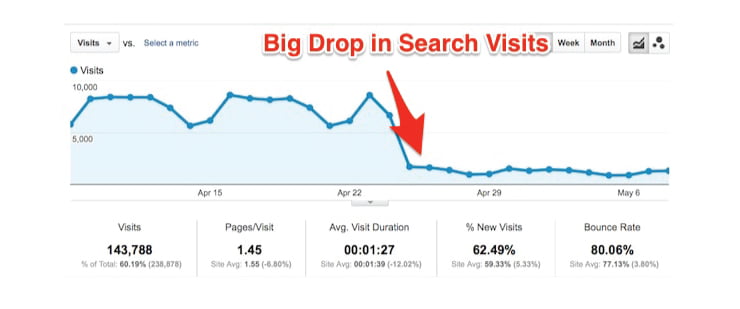Get rid of bad backlinks in 4 simple steps

Amongst the SEO industry, the term ‘link removal’ has become more and more prevalent as a result of the many changes Google have rolled out in a bid to prevent websites gaming search results by underhand tactics.
Years ago, link building was as simple as adding a website link to another site on the web. But more recently, over the last six years or so, Google has refined its ranking algorithm and as a result, has penalised companies taking part in shady link building activities. These activities are commonly known as black hat and grey hat techniques. Anyone who implements these techniques, whether knowingly or not, now face the problem of a sudden drop in rankings.
Reasons why you may need to consider link removal
- Negative SEO attack
- Google manual penalty
- Google algorithm penalty (known as Penguin)
The best way to determine if you’ve had some sort of penalty imposed on your website is to monitor your website via Google analytics. If you see a sudden drop in referral and site traffic for your target keywords – it’s time to act!

How do I remove bad links?
Link removal is a process of contacting the webmasters of the websites which contain a link to your website and asking them to kindly remove it.
However, such a process, which seems simple enough, can be quite a torrid task for many reasons, including:
- Webmaster unavailable
- Webmaster charging removal fees
- Webmaster refusing to remove the link
1) Get a current list of ALL links that point to your website
There are several tools available to do this – we recommend using Google Webmaster Tools to export the most up-to-date list of inbound links. You can do this by going to:
Search Traffic > Links to your site
Then clicking on Download Latest Links.

2) Identify the genuine links from the spammy looking ones!
Spammy links are defined as unnatural links from various places but typically, websites unrelated to your site, or from those horrid directory sites that are still around these days.
It sounds like a simple, straightforward task right? Whilst it may be simple enough to sift through potentially hundreds or thousands of inbound links, the trick is identifying which of these links are actually hurting your site’s ranking potential.
3) Begin the removal process by contacting webmasters
Again, there are various ways and means for doing this, but all involve a lot of leg work and research. You can start by performing a whois search on each of the suspect domains and recording the administrative contact details for them. Use Excel to keep a record.
With each domain then paired up with a contact name and email (ideally) – begin reaching out to the domain owner / webmaster and explain why you need to have your link removed. Its a good idea to record when you send the email to allow you to schedule follow ups if you don’t get a response. Tools like Gmail’s Boomerang are fantastic for this!
The important thing is logging all your efforts as you go, as this comes in handy when you reach the end of your target list.
This process should enable you to remove the links over a period of time but you should expect no guaranteed recovery results straight away.
4) If you’re struggling to get results, use Google’s Disavow tool
There’s a good chance that you’ll struggle to remove every single one of the spammy links – but this is where Google’s Disavow tool comes in handy.
* WARNING * Use this tool with caution!
The Disavow Tool should be your last resort for those links that you absolutely cannot remove. The tool lets you inform Google which links you’d like to have no association with – but it’s not as simple as just supplying them a list of links. You need to provide documented evidence (like your Excel spreadsheet in the above steps) to Google that you have tried to remove the links yourself. Many choose to use a cloud-based (Google Docs) spreadsheet to provide this evidence.
Its important that you carry out the research on the links to make sure you don’t disavow any links that are actually helping with your site’s rankings!
Before a Penguin recovery can be assessed fully, you will need to wait for the next refresh of the Penguin algorithm – although it was reported recently that Google intended to roll out regular updates of this algorithm as opposed to once a year, which is fantastic news for business owners looking to recover from link based penalties.










